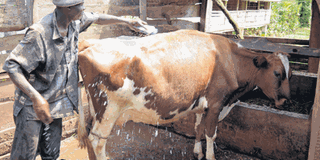Your cows need pedicure; here is how to do it right

Denis Wangila of the ACK, Kakamega, cleans an Ayrshire dairy cow at Moi Showgrounds ahead of the ASK Western show that begins on June 18, 2015. ISAAC WALLE |
What you need to know:
- But you have to do trimming properly to avoid hoof trimming miscues and to have the hooves return to normal shape. Poor or over trimming can result in lameness, so it is better to under trim than to over trim.
- Trimming the rear hooves is a different story! Cows don’t easily let you lift or hold their hind legs. In this case, one person can lift and hold onto the leg with one hand and the other hand around the ankle; taking care not to get kicked as the other person does the trimming.
It is important to regularly trim the hooves of your dairy cattle, especially those in confinement, to reduce the chances of lameness and predisposing to other diseases such as foot rot, abscesses or punctures.
It is no secret that cattle that have their hooves trimmed regularly are happier and more comfortable to stand longer time. When not trimmed, the hooves get misshaped and can easily cause foot injuries and pains.
But you have to do trimming properly to avoid hoof trimming miscues and to have the hooves return to normal shape. Poor or over trimming can result in lameness, so it is better to under trim than to over trim.
Exercise is important for your cow, yet any pain in the hooves will deny your cow this opportunity. The hooves can also overgrow and develop a false pad, which is firm and will cover the bottom of the real hoof hence prevents it from proper aeration. This causes pain.
Learn to make hoof trimming a regular practice anytime hooves get long or start to crack; without waiting for specific durations. If you trim after cracks have developed, you might require zinc supplements to firm up the hoof and prevent future cracking.
For a start, a farmer can hoof trim her heifers at about 4-6 months of age or to ensure hooves develop properly. Older cows can be trimmed at least twice per lactation, mostly around dry-off and about 70 to 150 days in milk.
The tools used for hoof trimming include a sharp knife or hoof nipper, hoof pick, rasp and a pair of gloves to protect your hands from contamination.
Before trimming, make sure your cow as comfortable as possible. By this, you will be able to finish trimming before the cow notices anything is going on.
STEPS IN FOOT TRIMMING
Step one: Confine the animal. One person can lift the front hoof while the other gently cleans.
Step two: Clean the hoof as much as possible using a hoof pick between the toes and edges. This will expose the area you are working with.
Step three: Run your finger across the hoof and you will notice a ridge around the edge. This is normally longer at this time of trimming and is also the initial boundary for cutting.
Step four: Trim around the bottom of the hoof, about half way on the edges of either hoof and down to the toe. Only trim off little layers at a time until you achieve the shape of the hoof. If you see a pink lesion, stop before you draw blood.
Step five: Finish by using a rasp to file off the rough hoof around the tip. This will not leave any area for bacterial growth.
Step six: Coat the hooves with iodine to aid in drying the hoof and as an anti-bacterial.
Step seven: Take the animal for a walk and have someone else evaluate her. This person should look out to see if the cow is limping, if she is walking evenly and all the four hooves are fairly equal in size and shape.
BE WARNED
Trimming the rear hooves is a different story! Cows don’t easily let you lift or hold their hind legs. In this case, one person can lift and hold onto the leg with one hand and the other hand around the ankle; taking care not to get kicked as the other person does the trimming.
During trimming, be careful that you do not make mistakes such as:
1. Removing excess outer wall of the hoof. This is common where trimming is done using a grinder and can increase chances of more white line disease.
2. Trimming the toes too short to result in the sole being too thin. Thin soles predispose the animal to white line disease and toe ulcers.
3. Excess trimming of the heel of the inner claw of the rear foot.
4. Removing the outer wall of the toe of the inner or outer hoof. This inner wall at the toe is the weight-bearing surface hence should not be removed.
5. Trimming the sole of hooves to an extremely concave shape instead of slightly concave or flat when placed on the ground. This especially applies to cows kept under concrete floors. When the cow stands on these floors, the claws get pushed apart thereby predisposing it to sole ulceration.
To compliment hoof trimming, several practices are important such as keeping cattle in dry areas. Use copper sulphate foot baths to help control foot infections like foot rot. Give the cows enough time and room to exercise. Always seek professional guidance.
Mr Opinya works in the department of Animal Sciences, Egerton University.





